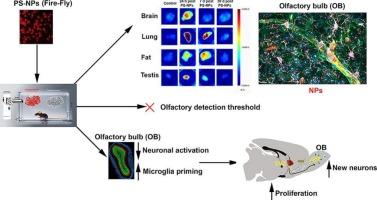纳米塑料吸入小鼠模型:组织生物分布及其对嗅觉系统的影响
IF 8
1区 环境科学与生态学
Q1 ENVIRONMENTAL SCIENCES
引用次数: 0
摘要
塑料碎片对人类健康的影响目前正在调查中,纳米塑料因其体积小而特别令人担忧。这使得它们可以被吸入,通过血液屏障,到达各个器官。在这项研究中,我们评估了空气中NPs对小鼠嗅觉系统的影响,这是NPs吸入的主要目标。成年小鼠暴露于含有合成聚苯乙烯纳米塑料(PS-NPs)的气溶胶溶液中,用红色荧光团标记,每天5小时,持续7天。生物分布分析显示,PS-NPs在脑组织、肺、脂肪组织和睾丸等组织中积累,但在一个月后被清除。本研究首次探讨了吸入PS-NPs对成年小鼠嗅球(OB)和脑室下神经发生的影响。我们观察到,暴露于PS-NPs后,OB的嗅觉辨别能力长期受损,神经元功能下降,小胶质细胞促炎激活。令人惊讶的是,我们注意到嗅觉神经发生的代偿性增加,尽管不足以抵消PS-NPs引起的嗅觉损伤。这些结果为吸入PS-NPs的潜在神经毒性作用提供了新的见解,并强调了评估这些污染物的职业和环境暴露的重要性。本文章由计算机程序翻译,如有差异,请以英文原文为准。

Inhalation of nanoplastics in the mouse model: Tissue bio-distribution and effects on the olfactory system
The impact of plastic fragments on human health is currently under investigation, with nanoplastics (NPs) being particularly concerning due to their small size. This allows them to be inhaled, pass through blood barriers, and reach various organs. In this study, we evaluated the effects of airborne NPs on the mouse olfactory system, which is a primary target of NPs inhalation. Adult mice were exposed to an aerosol solution containing synthetic polystyrene nanoplastics (PS-NPs) labelled with a red fluorophore for 5 h a day over 7 days. Biodistribution analysis revealed that PS-NPs accumulated in tissues, such as brain, lung, adipose tissue, and testicles, but were cleared after one month. This study is the first to investigate the effects of inhaled PS-NPs on the olfactory bulb (OB) and subventricular neurogenesis in adult mice. We observed long-term impairments in olfactory discrimination, decreased neuronal functionality, and pro-inflammatory activation in microglia in OB following PS-NPs exposure. Surprisingly, we noted a compensatory increase in olfactory neurogenesis, although insufficient to counteract the olfaction impairment induced by the PS-NPs. These results provide novel insights into the potential neurotoxic effects of inhaled PS-NPs and emphasize the importance of assessing occupational and environmental exposure to these pollutants.
求助全文
通过发布文献求助,成功后即可免费获取论文全文。
去求助
来源期刊

Science of the Total Environment
环境科学-环境科学
CiteScore
17.60
自引率
10.20%
发文量
8726
审稿时长
2.4 months
期刊介绍:
The Science of the Total Environment is an international journal dedicated to scientific research on the environment and its interaction with humanity. It covers a wide range of disciplines and seeks to publish innovative, hypothesis-driven, and impactful research that explores the entire environment, including the atmosphere, lithosphere, hydrosphere, biosphere, and anthroposphere.
The journal's updated Aims & Scope emphasizes the importance of interdisciplinary environmental research with broad impact. Priority is given to studies that advance fundamental understanding and explore the interconnectedness of multiple environmental spheres. Field studies are preferred, while laboratory experiments must demonstrate significant methodological advancements or mechanistic insights with direct relevance to the environment.
 求助内容:
求助内容: 应助结果提醒方式:
应助结果提醒方式:


